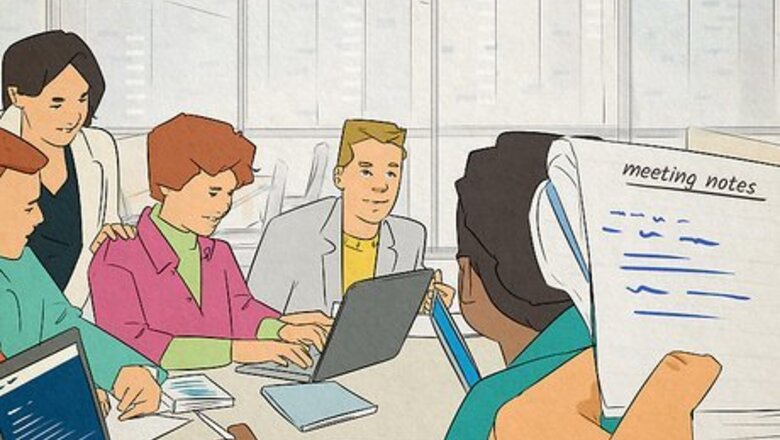
views
- Read the meeting's agenda in advance and jot down some "pre-meeting notes" so you'll have a general idea of themes and topics your facilitator will discuss.
- Decide on a note-taking format that works the best for you, like Cornell notes or mind maps, so that it feels quick and intuitive to record important ideas.
- Make sure that you highlight action items that specific team members are responsible for. Also point out ways colleagues can collaborate with each other.
- Share your documents with your entire team and refer back to them in future meetings, or "retrospectives," to analyze past insights.
What are meeting notes?
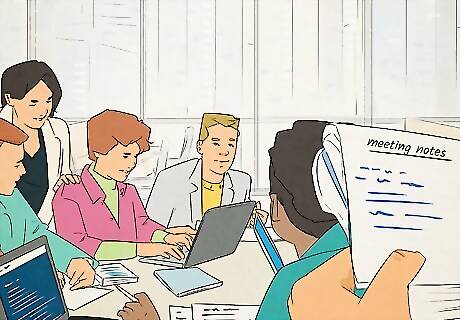
Meeting notes highlight key details that came up during a conference. Typically, a team appoints one note-taker who's responsible for compiling details like when a meeting took place, what its purpose was, who attended it, and what was discussed. Once the note-taker creates their report, it's available for all their colleagues to review and reflect on.
Taking Meeting Notes for a Team
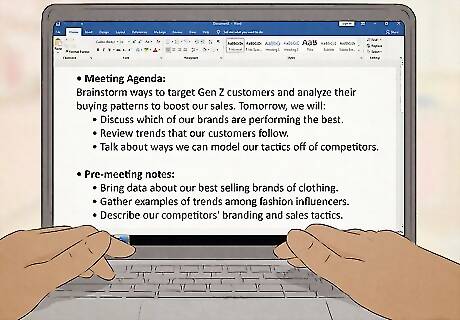
Take “pre-meeting notes” to prepare in advance. If the team facilitator gives you an agenda, get ready for the meeting by looking over their objectives. Write down ideas that the agenda inspires. If you're the facilitator, give your colleagues a chance to know what to expect by writing an agenda for your meeting. A little prep helps the conference run smoothly since everyone will be aware of what to discuss. Meeting Agenda: Brainstorm ways to target Gen Z customers and analyze their buying patterns to boost our sales. Tomorrow, we will: Discuss which of our brands are performing the best. Review trends that our customers follow. Talk about ways we can model our tactics off of competitors. Pre-meeting notes: Bring data about our best selling brands of clothing. Gather examples of trends among fashion influencers. Describe our competitors' branding and sales tactics.
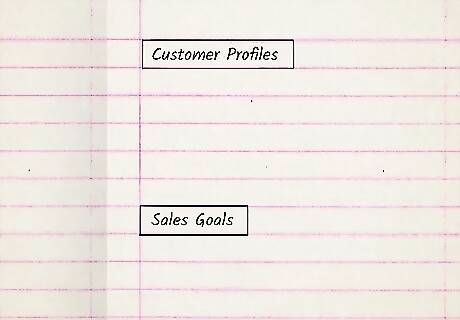
Create headers based on the topics in the meeting agenda. For example, make one header that says “Customer Profiles” and another called “Sales Goals.” To help your headers stand out, color-code them—for example, any headers related to consumer psychology could be blue, while those associated with making profits might be green. This basic outline makes it a quick process to fill in important details under the right headers. If you plan to type notes in a document, add tags to your outline. That way, you can just click on them to jump to that area in your meeting notes. You might add tags like “Trends” or “Market Research.” Your company might have note-taking templates, especially for specific kinds of meetings. For example, they might have a “Marketing Plan Brainstorm” template. Check in about what resources are available. To win some points with your colleagues, try a service like Canva to create a few note-taking templates everyone can use for future meetings. It’ll save them a lot of time. The best way to take notes electronically is to use a device with features that match your note-taking style. For example, use an Onyx BOOX Note Pro if you’re a visual thinker and like to sketch out your ideas.
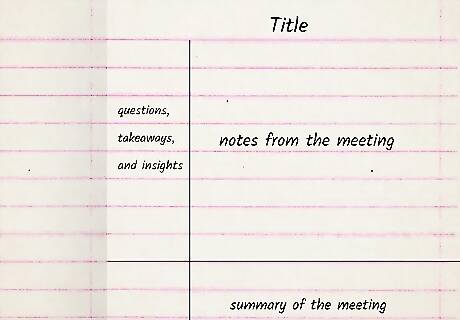
Choose a note-taking method to track details during the meeting. To make sure you’re efficient, take notes in a style that’s intuitive for you. Just focus on creating three distinct categories—general notes; questions, takeaways, and insights; a summary of the meeting—that are easy for you and your team to review later. If you're a linear thinker, you might like Cornell notes. To try them out, divide your paper into 3 sections: 1) Notes from the meeting 2) Questions, takeaways, and insights 3) A summary of the meeting When you fill out these sections, you can easily scan them from left to right to review the material. If you're more of a spontaneous thinker, try mind mapping. When you discuss a theme, like "Ad Campaigns," draw a circle and write that phrase in the center. Then, create lines that branch out of that circle to represent related ideas, like "Attractive Imagery" and "Appeal to Emotions." When you're done with your mind map, remember to write a summary of your meeting—if you want to, record this on the back of your piece of paper.
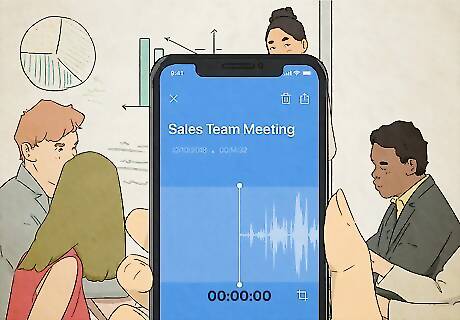
Transcribe conversations with recording software. While you should still take meeting notes, if you transcribe meetings with a program that turns audio into text, like Rev Voice Recorder or Otter, you'll have a good backup document to refer to. You and your colleagues can easily scan it and check if there were any ideas you missed. It's usually a lot easier to review a transcript than to watch a video recording again or to ask people to repeat what they said in a previous meeting. For an enhanced transcript, highlight all of the key ideas and/or action items. Make sure you get everyone's consent before recording what they say.
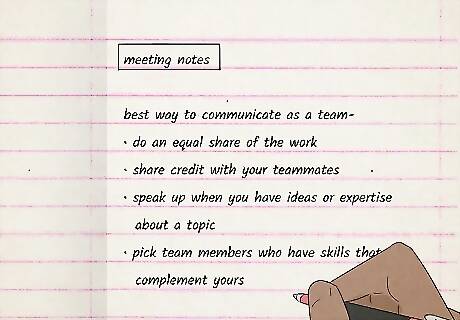
Use pen and paper to improve your recall. When you write by hand, you're more likely to remember the material covered in a meeting. If you want to be more engaged with what the team facilitator and your colleagues are saying, then listen closely, decide which information is most important, and record details you find invaluable. Research shows that when you take notes by hand, you'll have better recall of phrases and you'll perform better in tasks where you need to remember key concepts. On the other hand, if you type, you're more likely to slip into "in verbatim" note-taking, in which you type every single thing a person says instead of deciding which ideas are most important. Even if you're able to write quickly by hand, try not to record everything in verbatim. Instead, jot down key details so you retain those and become very familiar with them.
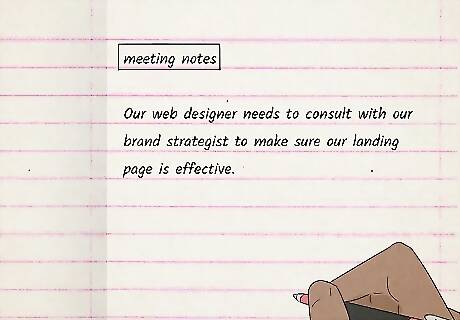
Highlight action items for each member of the team. Write down whenever there’s a specific task someone needs to accomplish. For example, if the speaker mentions your company website is due for a redesign, note that this is an action item for your team’s web developer. Touch base with everyone so they know how they can contribute to your company’s goals. Remember to make a note when you have an action item, too. Action items can come up in the beginning, middle, or end of a meeting. Bring up when there are important points of contact (times people need to follow up with each other). For example, write, "Our web designer needs to consult with our brand strategist to make sure our landing page is effective." For easy reference, group all the action items together at the end of your meeting notes. Everyone will be able to find them and know what to work on next.

Share your notes with all your colleagues. Keep everything above board and encourage active participation, even if it's asynchronous (happening at different times). Make sure everyone has access to your document. If you wrote down your notes, scan them and turn them into PDFs, then email them to everyone. Your amazing meeting notes will serve as a touchstone everyone can return to and refer to when they need guidance. In addition to writing notes, you can use Google Sheets to type key takeaways and action items into a shareable spreadsheet. Remember to remind anyone who's out of the office to check their inbox for the meeting notes. Check if there's a central hub or cloud server where you can upload your meeting notes.
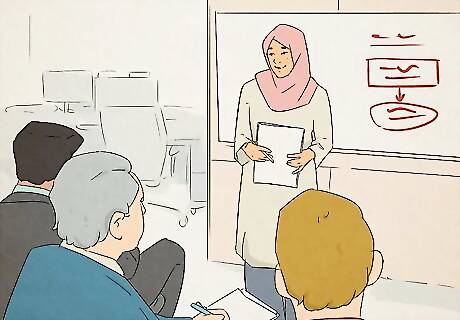
Refer to your notes in retrospectives. Hold a “retrospective,” a meeting in which your company reviews a past project (like a product launch), to unpack what went right, what could be improved on, and what your goals are for the future. Dive into your meeting notes to see what insights were accurate and which assessments could be tweaked for your team’s next vision. What went right: "Our updated landing page drove up web traffic by 200%. Based on our meeting notes, we should continue to pair our web developer with our brand strategist." Assessments to tweak: "In our last meeting, we thought that Halloween was an ideal time to roll out a new lineup of accessories, but our sales reports suggest that consumers spend more money after Black Friday." Goals for the future: "Next holiday season, we'll focus more of our resources on ad campaigns that we'll release between Thanksgiving and Christmas."
Benefits of Meeting Notes

Meeting notes allow an entire team to be on the same page. When you use a note-taking style that’s clear to read and easy to extract information from, then all of your co-workers can have a strong idea of what to do next. Essentially, meeting notes give an accurate description of what happened at a conference and what’s expected of everyone. Meeting notes also: Allow collaboration and feedback Make sure every attendee understands main takeaways Document decisions everyone agreed to Bring attention to specific action items people need to make Increase motivation and drive a project forward Help facilitate communication among multiple teams in a company Improve recall so team members remember important standards and goals Create chances for people to participate at different times (known as “asynchronous participation”)
What are meeting minutes?

Meeting minutes are a very formal way to record certain conferences. When a person takes meeting minutes, it's usually to have an official record of a meeting or hearing. For example, a board or a committee might take meeting to document new procedures or laws that the members agreed on. Typically, most businesses or organizations don't need meeting minutes—team members usually just want to review more abstract ideas like themes, topics, and goals.
















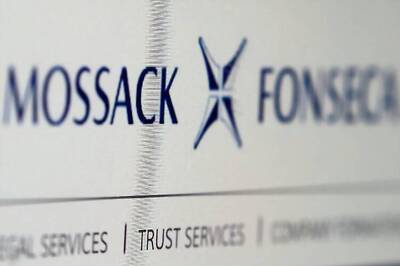
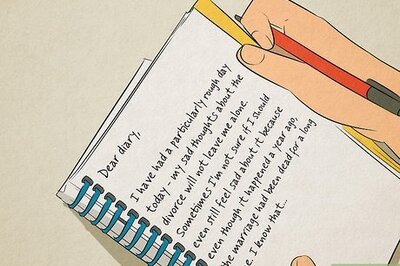

Comments
0 comment